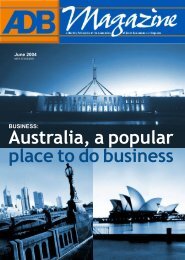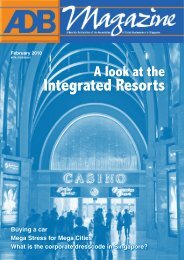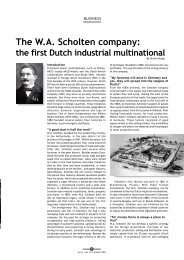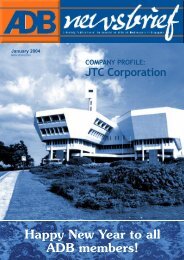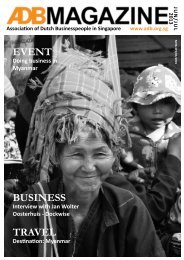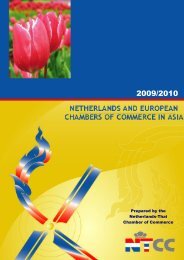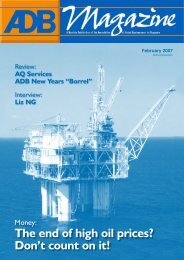November 2010 - Association of Dutch Businessmen
November 2010 - Association of Dutch Businessmen
November 2010 - Association of Dutch Businessmen
Create successful ePaper yourself
Turn your PDF publications into a flip-book with our unique Google optimized e-Paper software.
Business<br />
Doctrine <strong>of</strong> Ants and Ostriches<br />
Text Frank Kuijsters<br />
Source From the book Animal Firm <strong>of</strong> M. Schreurs and S. van de Veer<br />
Successful organizations have in common the same as in<br />
groups living species. What can you learn from elephants,<br />
ants, coal tits and ostriches?<br />
Successful organizations have certain characteristics<br />
in common such as long-term orientation and quality<br />
leadership. What emerges: in groups living species are<br />
paragons <strong>of</strong> such behavior. Below what you can learn from<br />
elephants, wild dogs, ants, coal tits and ostriches.<br />
The elephant<br />
The quality <strong>of</strong> the leadership <strong>of</strong> the matriarch is crucial.<br />
Quality leadership means that the matriarch, as the oldest<br />
and most experienced elephant, the direction, the herd<br />
‘coached’ to a new target, the togetherness in the herd<br />
monitors and a strong role model. What does that matter?<br />
The matriarch always acts in the interest <strong>of</strong> the group, is<br />
results-oriented, decisively and sets clear frameworks. For<br />
example, the matriarch decides where and when the group<br />
stops, for example, to drink or to sleep and when there is<br />
drained under gravity. A key element <strong>of</strong> its behavior is that it<br />
serves to protect the next generation.<br />
A successful Manager builds trust by integer and<br />
developing coaching style <strong>of</strong> leadership combined with<br />
strong example behavior, quick decision-making (also about<br />
non-Achievers’) and focus on results, working from a longterm<br />
vision.<br />
The African wild dog<br />
The wild dog is an animal in a ‘tough market’ special long<br />
term orientation properties <strong>of</strong> shows. Typical behavior <strong>of</strong><br />
African wild dogs is their social cooperation. They encourage<br />
each other and encourage each other to be successful.<br />
On obtaining result each Member <strong>of</strong> the Pack has a task.<br />
Successful hunting techniques will be shared with future<br />
generations, because long-term survival is for short-term<br />
gain. The pack is a safe environment, where the group<br />
interest is above the individual interest.<br />
A successful manager is focused on continuity in the<br />
long term and for pr<strong>of</strong>it in the short term. The manager<br />
creates a safe and stable work environment. It’s long-term<br />
thinking is aimed at all stakeholders <strong>of</strong> the organization:<br />
the society, customers, suppliers, employees, government,<br />
social groups. Everyone benefits from it.<br />
The Ant<br />
Ants are continuously working on knowledge sharing to<br />
work together more effectively. Each ant in the colony takes<br />
alternating the role <strong>of</strong> master or journeyman. If an ant has<br />
certain knowledge, such as a food source, he is the master<br />
automatically. He shares his knowledge with the other ants,<br />
the companions. Ants make mistakes, but learn from each<br />
other how things can be improved. They are sensitive to<br />
non-verbal communication and linking directly to actions.<br />
A successful Manager creates an open culture where<br />
employees are frequently involved in key processes, the<br />
dialogue with one another, share knowledge, learn from<br />
mistakes, change encourages and pick up actions to achieve<br />
better performance.<br />
The Crow and the Tit (mees)<br />
Simplify, enhance, refresh: the tit and the crow have a rich<br />
creative ability to find new and smart solutions. In other<br />
words, they’re particularly innovative. The special feature<br />
<strong>of</strong> them is that they improve continuously based on the<br />
‘lessons <strong>of</strong> life’. Crows show how ingenuity and creativity can<br />
help improve performance. Both birds show attributes that<br />
an organization needs to stand out. All <strong>of</strong> this is fueled by an<br />
important property: unprecedented curiosity.<br />
A successful Manager lets employees always strive to<br />
the best possible result and the best out <strong>of</strong> themselves,<br />
colleagues and the organization. This manager provides<br />
a distinctive strategy and let everyone help to improve,<br />
simplify and tuning processes, services and products.<br />
The wildebeest, zebra, giraffe and ostrich on<br />
the savanna<br />
Wildebeest, zebras, ostriches and giraffes pull side by side,<br />
flanked by antelopes and other small animals. Predators<br />
<strong>of</strong>ten see too many preys and try then the old, sick and<br />
young animals <strong>of</strong> the group. To solve this ‘organization<br />
problem’ <strong>of</strong> inattention these so-called prey animals form<br />
together a diverse and complementary team. Cooperation<br />
and group interests are <strong>of</strong> utmost importance. By combining<br />
their diversity <strong>of</strong> strong features they become stronger<br />
against predators.<br />
A successful Manager builds diverse and complementary<br />
teams at all levels in the organization.<br />
*<br />
Autohuur tarieven vanaf € 23,- per dag<br />
all-in<br />
Laagste eigen risico - Geen extra verzekeringen bij aankomst - No nonsense voorwaarden<br />
www.bblcarrental.nl<br />
*28+ dagen tarief categorie A, excl. Schipholfee<br />
<br />
bb&l_<strong>2010</strong>_ad_194x61.indd 2<br />
12/9/09 4:13:43 PM



